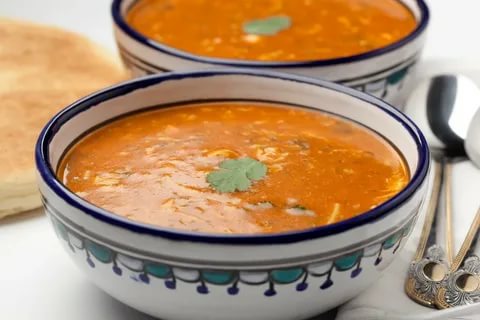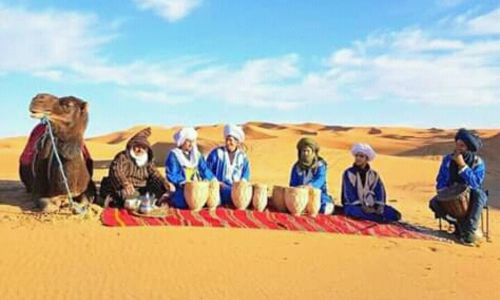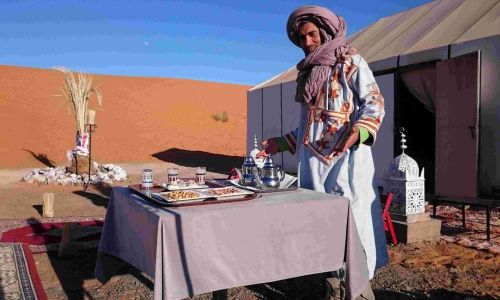MOROCCAN SOUP: HARIRA RECIPE
Harira soup is the most traditional moroccan soup a taste rich dish that was typically related to the break of fast in Ramadan. This moroccan soup put an end to a fast of 15 hours or more in climates often testing for human resistance. This is no longer the case today and the problem is that if it continues to tickle our hungry nostrils or if they go to smell the air, it has become the inevitable, as obligatory and somewhat sacred element of our tables composed of an indecent number of foods that we have been craving throughout the day of fasting, enthroned in the middle, but among … other soups, four kinds of honey cakes, two kinds of pancakes, fruit juices, various dairy products, yoghurts, cheeses, eggs, fresh fruit, various pastries … and the worst of them.

MOROCCAN SOUP RECIPE. HOW TO COOK HARIRA IN 6 STEPS
Harira ingredients :
- 1 minced onion
- 1 small bunch of chopped parsley
- 1 bunch of fresh coriander, minced
- 100 g dried chicory peas
(soaked the day before in water and removed their skin) or canned chickpeas. - Spices: (1/2 teaspoon turmeric, 1/2 teaspoon x ginger, 1/2 tsp. pepper, 2 tsp. salt)
- 50 g flour + a little water (to prepare the binder for the soup)
- 150 g of meat of your choice cut into small cubes
- A few celery stalks, thinly sliced (without the leaves)
- 50 g of lentils (preferably roses)
- 1 to 2 tablespoons of olive oil
- 1/2 teaspoon rancid butter (optional)
- 2 liters of water
- 700 g of tomato
- 1 tablespoon tomato paste
- The juice of half a lemon (optional)

Instructions to cook moroccan soup :
1. Chop the onions, parsley, coriander and celery and mix the tomatoes (I use canned tomatoes otherwise chop the fresh tomatoes and remove the skin).
2. In a pot, brown the meat in small cubes, add the onions, parsley, coriander and celery and leave to sweat for a few minutes.
3. Add the lentils, the dry chickpeas soaked the day before in water (if you use canned chickpeas, they are pre-cooked, so you will have to put them at the end of the cooking), and the spices (turmeric, pepper, ginger, salt, you can also add a pinch of cinnamon). Moisten all with a good quantity of water (2 liters), cover and cook until the chickpeas become tender.
4. Preparation of the binder. Dilute the flour in water in order to have a liquid preparation without the lumps (pass this preparation in a Chinese if it is necessary).
5. Once the chickpeas and lentils are cooked, leave the casserole on the fire and add the rice or vermicelli, possibly add the canned chickpeas, leave the rice to cook for a few minutes. Add the binder (flour preparation) little by little and continue to stir to prevent the flour from sticking to the bottom. You will have to add the binder step by step until you have a velvety soup (the more you add, the thicker the harira becomes).
6. Cook for another 2 to 3 minutes over medium heat, stirring constantly.
At the end of cooking, add the freshly chopped coriander and lemon juice according to taste.
The Harira is accompanied by hot or cold starters such as bourek stuffed in different ways and maakouda.
Harira nutritional values
As it has been described there are different harira recipes which means different nutritional value. To get an aproximate idea of the harira nutritional value we can take these data:
Portion Size: 100 g
Energy 461 kj6 (110 kcal)
Caloric distribution:
Carbohydrate (54%)
Fat (32%)
Protein (14%)
Per portion % AR*
- Fat 3.89g6%
Saturated Fat0 0.527g3%.
Monounsaturated Fat 1,987g
Polyunsaturated Fat 1,107g
Carbohydrates 15,14g6 - Sugar0.94g1%
- Fiber2,1g
- Protein 3.83g8%
- Salt 0.36g6%
- Cholesterol 5mg
- Potassium 157mg8
Traditional harira. Andalusian and Muslim origins
The harira is probably the dish of Morocco for which no two regions, two families or even two individuals give the same recipe. One will always recognize that it is the harira, it will never have the same taste.
Before being Moroccan, the harira has its roots in history. An analysis that leads to the origins of the soup, which in its early days was possibly cooked without meat. Even today, there are regions in Morocco where the harira is prepared only with vegetables.
Originally, according to some researchers recipes for harira already existed in medieval culinary literature. For others, the harira is of Andalusian origin and later became the most popular soup in Orania after the chorba. It would have been introduced in Algeria in 902 by Andalusian sailors, before the fall of Al-Andalus and influenced by the moriscos of Cordoba who called it harira qarsa because of its acidity due to the lemon. Still others plead for a Berber origin of the soup. The seven-ingredient soup called harira had already been mentioned by Qur’anic scholars Ahmed Ibn Hanbal and Mohamed el Bukhari, and was supposed to be part of the dishes of the agricultural populations of the Arab world before the Hegira.
Harira in Moroccan Ramadan tables
An anonymous manuscript on the cuisine of Marrakech offered three recipes for gachicha, of which “the first is very close to the current recipe for harira, in that it is prepared in two stages, with chicken as meat. That said, the text is unanimous: “the harira, the true, authentic, I was told, is bufertuna, at least in Fez and Rabat. The harira would thus draw its roots in the cities of Fez and Rabat where it would be more commonly called bufertuna.
“The true character of bufertuna, its secret, is the preparation of the flour coulis”, a coulis which was prepared according to ancestral traditions with leaven taken from the bread dough of the day before. An action that characterizes this ingredient as “good fortune”. The word would be a simplification of the Spanish expression “buena fortuna”, which in particular expresses good luck. On this point, the researcher succinctly recalls that the harira, “outside Ramadan, it is served the day after wedding nights, births, circumcisions, but also funerals, we say that bufertuna accompanies the great turning points of life”. A well-kept secret of the Rbatis and Fessis as for the flagship soup of the kingdom.
The consistent dish has thus crossed times and centuries before arriving and being inherited by Moroccans, especially in winter and more traditionally during Ramadan. And for good reason, the dish includes a set of ingredients to regain strength after a hard day of fasting. A habit kept from our ancestors who used to consume the harira as a unique, rich and complete dish at the time of the break. This put an end to hours of fasting often in a very trying climate.
However, today, nutritionists are firm about the consumption of harira, it must remain exceptional and must be consumed in small quantities. Often described as heavy and indigestible because of its fat and flour content, this soup would be nutritionally questionable.
Throning amidst the flavors of the beautiful Moroccan tables of the sacred month, bufertuna, harira, chorba, asskif, tahrirt, harira bida (white), hsouwa or belboula, depending on the different regions, still has good days ahead of it since it is the culinary heritage of the kingdom, especially during Ramadan.
(Source: https://www.yabiladi.com/articles/details/54023/harira-est-elle-vraiment-marocaine.html)
DISCOVER OUR TOURS TO SAHARA DESERT IN MOROCCO

FROM MARRAKECH
Our most popular Morocco Sahara Tours . The trip from Marrakech is rich in scenery and includes an unforgettable stay in a Desert Camp.

FROM FES
A great experience starting from Fes including camel trekking and at least one night in a tented desert camp in the Merzouga Desert.

CUSTOM TOURS
Our experts can create exceptional tailor-made experiences for our clients. Contact us and we´ll plan your perfect trip in Morocco.
